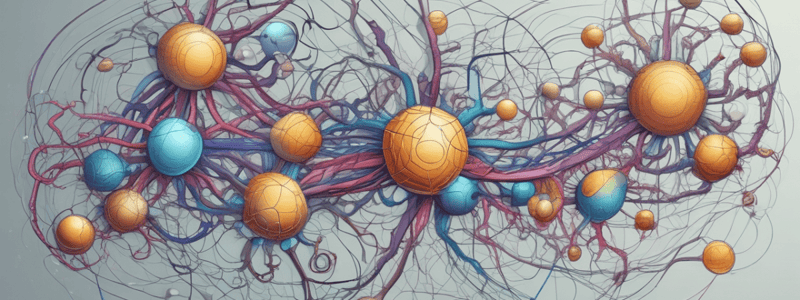Podcast
Questions and Answers
What type of NT release occurs randomly and is thought to play a part in maintaining basal neurotransmitter levels and modulating synaptic strength?
What type of NT release occurs randomly and is thought to play a part in maintaining basal neurotransmitter levels and modulating synaptic strength?
- Calcium-independent
- Asynchronous
- Synchronous
- Spontaneous (correct)
What is the role of synaptotagmin-1 in vesicle fusion?
What is the role of synaptotagmin-1 in vesicle fusion?
- To regulate vesicle docking
- To recycle vesicles
- To inhibit vesicle fusion
- To promote vesicle fusion (correct)
What is the purpose of positional priming in vesicle release?
What is the purpose of positional priming in vesicle release?
- To regulate calcium entry
- To allow vesicle docking
- To move vesicles towards docking sites (correct)
- To fuse vesicles with the plasma membrane
Which type of NT release can persist for a longer duration after cessation of action potentials?
Which type of NT release can persist for a longer duration after cessation of action potentials?
What is the role of SNARE proteins in vesicle release?
What is the role of SNARE proteins in vesicle release?
What is the term for the simultaneous release of multiple neurotransmitters from the same presynaptic terminal?
What is the term for the simultaneous release of multiple neurotransmitters from the same presynaptic terminal?
What precedes vesicle fusion in the process of synchronous NT release?
What precedes vesicle fusion in the process of synchronous NT release?
What is the primary function of spontaneous NT release?
What is the primary function of spontaneous NT release?
Which type of NT release is most closely associated with the movement of vesicles towards docking sites?
Which type of NT release is most closely associated with the movement of vesicles towards docking sites?
What is the primary mechanism by which vesicle fusion occurs in synchronous NT release?
What is the primary mechanism by which vesicle fusion occurs in synchronous NT release?
Which type of NT release is most closely associated with the release of neurotransmitters from the vesicle?
Which type of NT release is most closely associated with the release of neurotransmitters from the vesicle?
What is the primary function of molecular priming in vesicle release?
What is the primary function of molecular priming in vesicle release?
Which type of NT release is most closely associated with the release of multiple neurotransmitters from the same presynaptic terminal?
Which type of NT release is most closely associated with the release of multiple neurotransmitters from the same presynaptic terminal?
What is the primary function of SNARE proteins in vesicle release?
What is the primary function of SNARE proteins in vesicle release?
Flashcards are hidden until you start studying
Study Notes
Types of Neurotransmitter Release
- Spontaneous neurotransmitter release occurs in the absence of action potentials or external stimuli, happening randomly and thought to play a part in maintaining basal neurotransmitter levels and modulating synaptic strength.
Asynchronous Neurotransmitter Release
- Asynchronous release occurs following neuronal activity and can persist for a longer duration after cessation of action potentials.
Synchronous Neurotransmitter Release
- Synchronous release occurs in response to a single action potential, involving:
- Presynaptic depolarisation
- Calcium entry
- Vesicle movement and priming
- Positional priming: movement of vesicle towards docking sites
- Molecular priming: molecular changes that allow docking and fusion
Vesicle Docking and Fusion
- Vesicle docking involves the use of SNARE proteins:
- Synaptobrevin on synaptic vesicles
- Syntaxin and SNAP-25 on presynaptic membrane
- These proteins join together, allowing vesicle docking
Vesicle Fusion and Recycling
- Vesicle fusion is triggered by the influx of Ca2+, leading to synaptotagmin-1 binding to the SNARE complex, promoting vesicle fusion
- Vesicle recycling is necessary for further neurotransmitter release
Co-Release
- Co-release is the simultaneous release of multiple neurotransmitters from the same presynaptic terminal, used to control the size of the action potential generated
Types of Neurotransmitter Release
- Spontaneous neurotransmitter release occurs in the absence of action potentials or external stimuli, happening randomly and thought to play a part in maintaining basal neurotransmitter levels and modulating synaptic strength.
Asynchronous Neurotransmitter Release
- Asynchronous release occurs following neuronal activity and can persist for a longer duration after cessation of action potentials.
Synchronous Neurotransmitter Release
- Synchronous release occurs in response to a single action potential, involving:
- Presynaptic depolarisation
- Calcium entry
- Vesicle movement and priming
- Positional priming: movement of vesicle towards docking sites
- Molecular priming: molecular changes that allow docking and fusion
Vesicle Docking and Fusion
- Vesicle docking involves the use of SNARE proteins:
- Synaptobrevin on synaptic vesicles
- Syntaxin and SNAP-25 on presynaptic membrane
- These proteins join together, allowing vesicle docking
Vesicle Fusion and Recycling
- Vesicle fusion is triggered by the influx of Ca2+, leading to synaptotagmin-1 binding to the SNARE complex, promoting vesicle fusion
- Vesicle recycling is necessary for further neurotransmitter release
Co-Release
- Co-release is the simultaneous release of multiple neurotransmitters from the same presynaptic terminal, used to control the size of the action potential generated
Studying That Suits You
Use AI to generate personalized quizzes and flashcards to suit your learning preferences.



